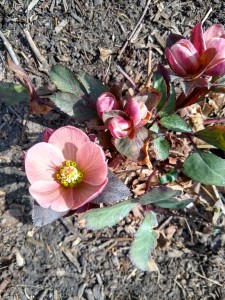 It is hard to get down on your stomach in the garden at any time of year, but especially so when the ground is cold or damp. Clearly flowering plants don’t care about your comfort, because the best way to see some of them is from underneath. Snowdrops, with their drooping, winged flowers are one. Hellebores—especially those known botanically as Helleborus x hybridus, Helleborus orientalis, or more commonly, Lenten roses–are another.
It is hard to get down on your stomach in the garden at any time of year, but especially so when the ground is cold or damp. Clearly flowering plants don’t care about your comfort, because the best way to see some of them is from underneath. Snowdrops, with their drooping, winged flowers are one. Hellebores—especially those known botanically as Helleborus x hybridus, Helleborus orientalis, or more commonly, Lenten roses–are another.
You might emulate English garden writer Beverley Nichols and solve the problem by digging up an entire clump, taking the clump indoors and positioning it on top of a small mirror. This is effective, but almost as much trouble as getting down on your belly, when you consider the eventual need to replant the clump in the same cold soil from which you removed it.
If all that digging seems like too much work, you could harvest the nicest of the Lenten rose blooms in your garden and float them in a shallow, water-filled bowl. Magazine stylists do this all the time. In my experience floating arrangements look great for about 24 hours—long enough for a dinner party–but fade quickly after that.
While digging clumps or floating flowers may improve your morale, neither option will do anything to lift the nodding hellebore faces in the garden.
Some gardeners deal with that by relying on hybrids of Christmas rose or Helleborus niger. These bloom even earlier than Lenten rose, and certain varieties, notably the Gold Collection hellebores, originally bred in Germany by Josef Heuger of Heuger International, feature outward facing blooms. The Gold Collection Christmas roses are often sold in midwinter or early spring as mature, blooming plants. I have even found them in my local grocery store. The hybrids, with names including ‘Pink Frost’, ‘Merlin’ and ‘Cinnamon Snow’ sport large, outward-facing flowers in white, cream or shades of pink. The range of colors is smaller than that of Lenten roses, but the flower quality makes up for it.
Of course, if you love the later-blooming Lenten roses, you could simply admire the flower shapes and colors from above and let the flower “faces” take care of themselves. The early spring bees can find the pollen no matter what you do.
Still, elevating the gardener’s morale is important at all times, and elevating the hellebore blooms might help. I would advise seeking out hellebore varieties with outward-looking faces. Breeders are creating more and more of them.
Consider the Frostkiss hellebore series, trademarked, as all new plant introductions seem to be now. These may not have Helleborus orientalis in their parentage, but are generally grouped with Lenten roses. All feature outward-facing flowers. While the color range-white, pinks, red—is not as great as some Lenten rose offerings, the flowers stand out, as do the purplish stems and white-veined foliage. Available varieties include ‘Molly’s Kiss”, in white; ‘Moondance’, with greenish white blooms; ‘Penny’s Pink’, in dusty rose; ‘Glenda’s Gloss’, with greenish-white petals edged in purple; ‘Cheryl’s Shine’, featuring pale pink blooms with darker pink edges; ‘Pippa’s Purple’, which is actually a very deep pink with darker freckles; and ‘Anna’s Red’, which is a true red. All are single-petaled varieties and share the carefree nature and long bloom period that marks all hellebores. As with other hellebores, deer don’t like them, and that increases your chances of actually being able to enjoy them in the garden.
‘Blue Lady’, which is not part of the Frostkiss series, is also outward facing, with deep rose petals that give way to darker rose close to the flowers’ centers.
Now that breeders have broken though the outward-facing barrier, hellebore lovers can probably expect more of the same in the coming years. Outward facing doubles would be lovely, as would the yellow and peach-toned varieties that ornament assortments of the more traditional, downward-facing Lenten roses.
Whether your Lenten roses face out or down, all require light shade, rich soil and moisture during dry spells and hot summers. In older hellebore varieties, large palmate leaves sometimes overwhelm the shy, downward-facing flowers. Newer varieties are more likely to feature blooms that stand above the foliage. All hellebores look better when the mature, winter-ravaged leaves are removed in the spring.
I would never advocate getting rid of your downward-facing hellebores, because they are beautiful and useful in their own right. If you have the space and inclination, mix in some of the upturned ones and revel in the best of both worlds while you await the fusillade of later blooming spring flowers.
The Frostkiss series is available wherever Monrovia plants are sold. Find local Monrovia retailers by using the tool available at https://www.monrovia.com. Click on the “Find a Garden Center” tab at the top of the page. ‘Blue Lady’ is available at Annie’s Annuals, 740 Market Ave.
Richmond, CA 94801; 1.888.266.4370; www.anniesannuals.com. Print catalog available.
